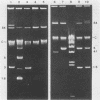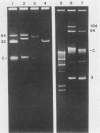Abstract
A survey of Salmonella infections was carried out over a 1-year period in the rural community covered by the Hospital Reina Sofía (Tudela, Spain). The 255 strains that were collected were studied by serotyping, antimicrobial resistance, and plasmid profile analysis. The predominant serotype was S. enteritidis (85.90%), followed by S. typhimurium (7.06%) and S. virchow (2.36%). Only 7.84% of the strains were resistant to antimicrobial agents. The most common resistance was to beta-lactam antibiotics. This resistance was due to the presence of one of two types of beta-lactamases, TEM-1 or TEM-2. Resistance to kanamycin was associated with the synthesis of a 3'-O-phosphotransferase. The resistance to streptomycin and chloramphenicol was either not enzymatic or was due to a 3"-O-phosphotransferase and a chloramphenicol acetyltransferase, respectively. Analysis of total plasmid DNA content revealed the presence of plasmids in 96.08% of the isolates. According to their plasmid profile, the strains could be classified into different groups. The three main groups, which accounted for 50.19, 20.78, and 4.70% of the isolates, respectively, corresponded to the antimicrobial-susceptible S. enteritidis serotype. These results suggested that plasmid profile analysis in conjunction with antimicrobial resistance determination can be useful for subtyping resistant Salmonella isolates.
Full text
PDF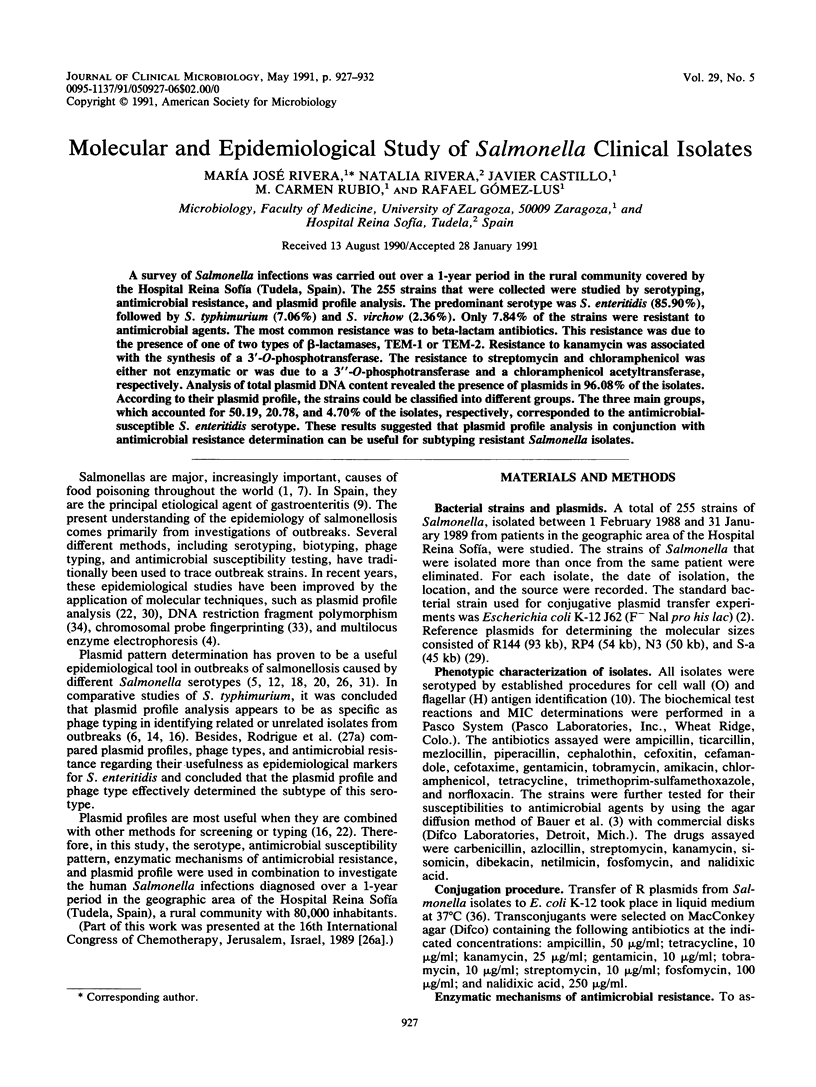
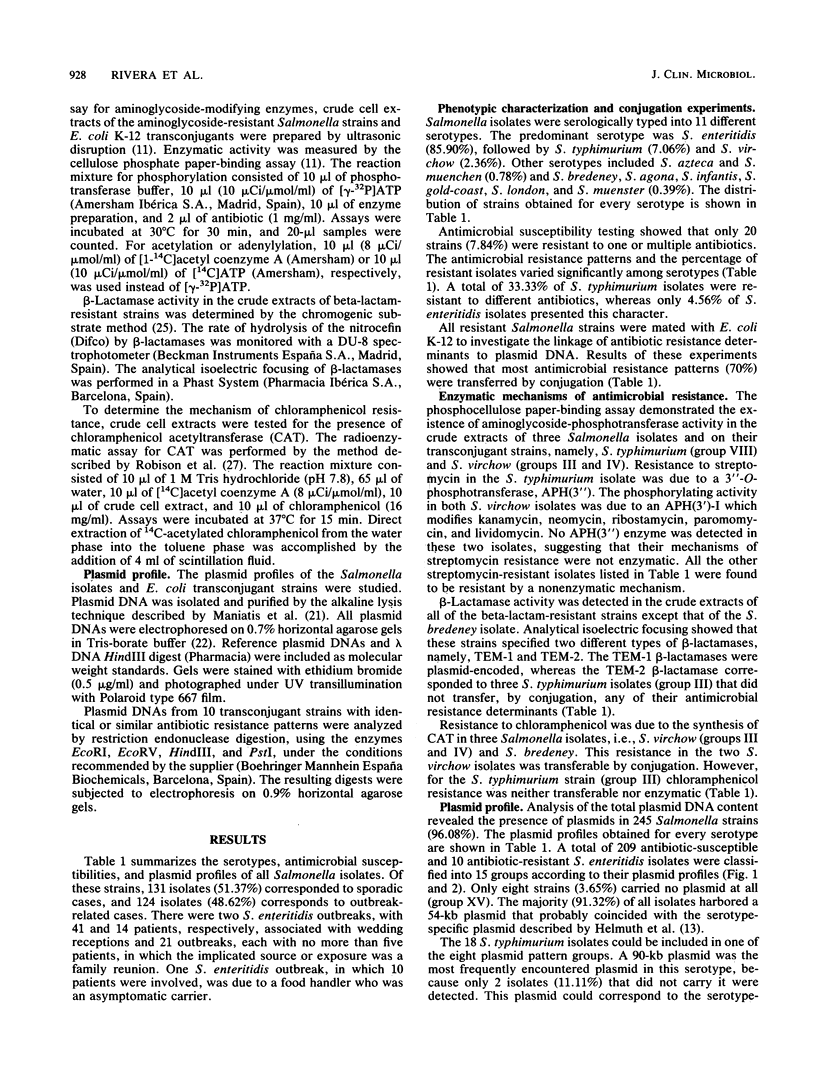
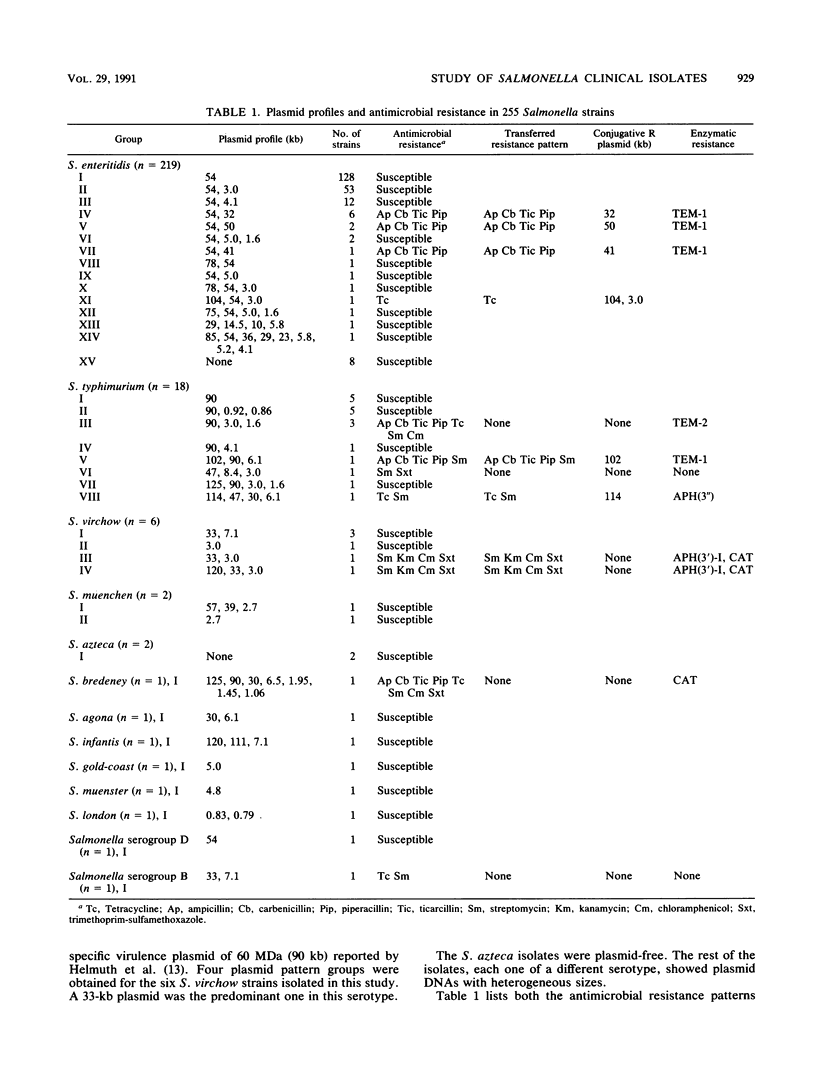
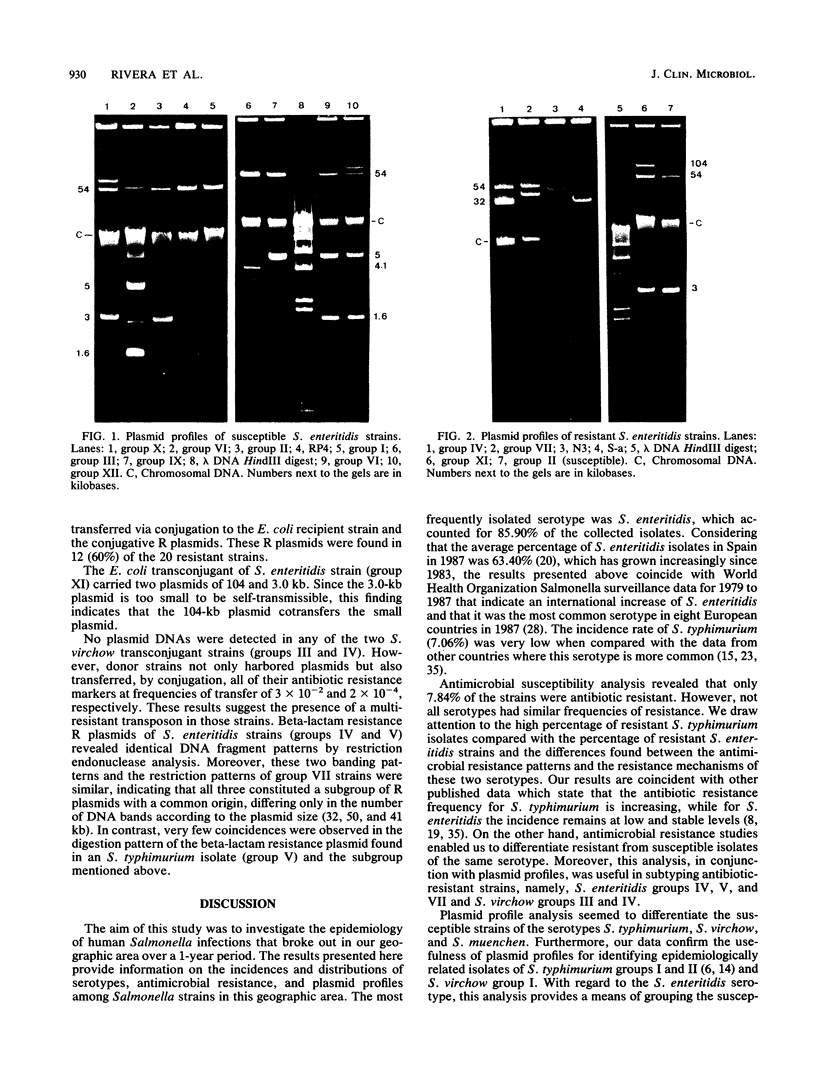
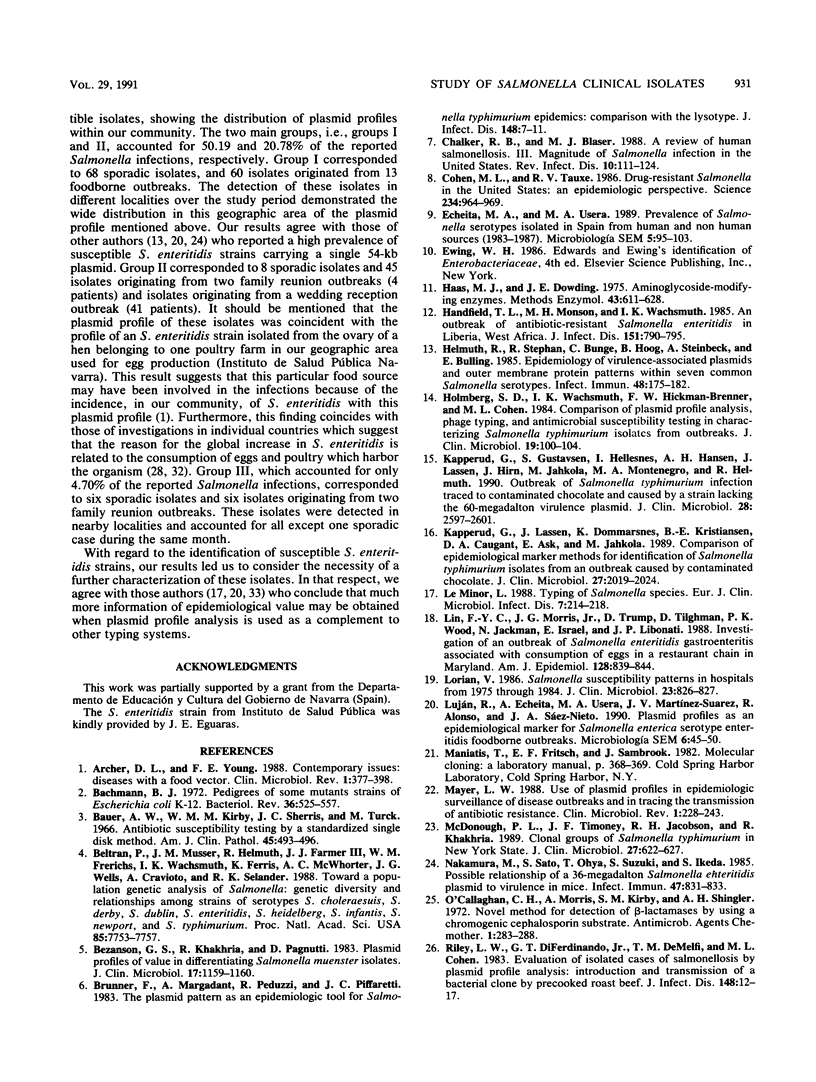
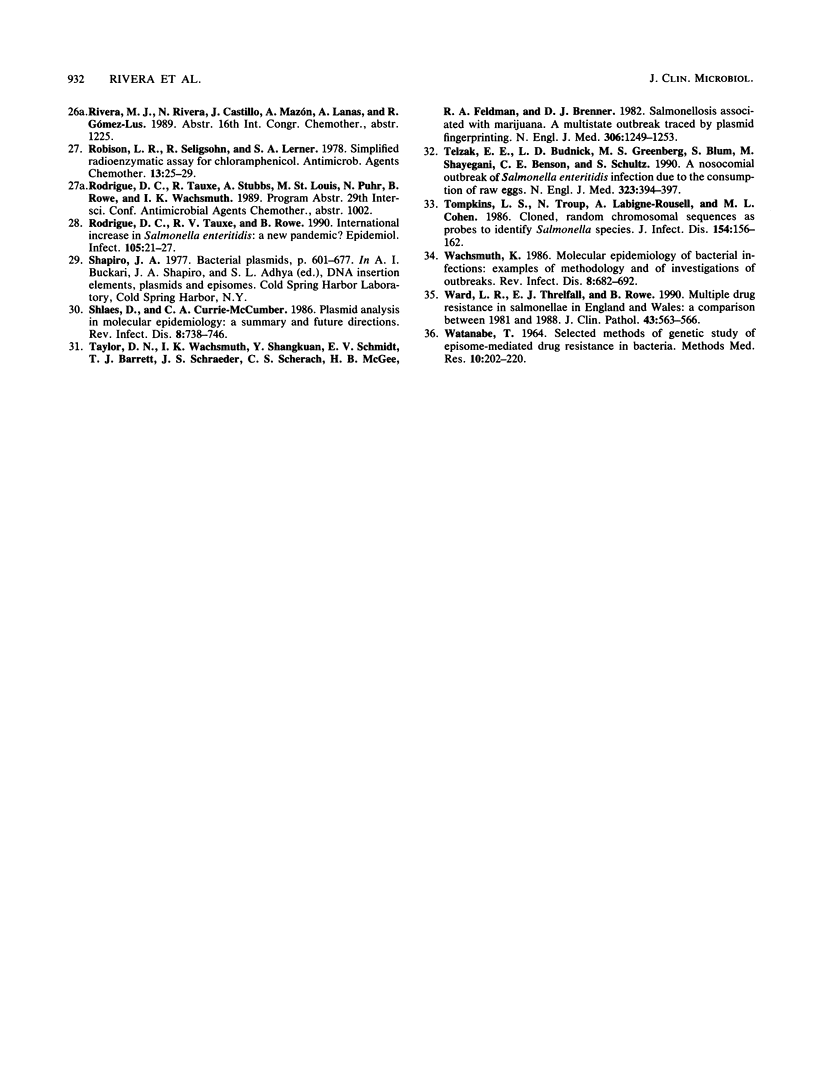
Images in this article
Selected References
These references are in PubMed. This may not be the complete list of references from this article.
- Archer D. L., Young F. E. Contemporary issues: diseases with a food vector. Clin Microbiol Rev. 1988 Oct;1(4):377–398. doi: 10.1128/cmr.1.4.377. [DOI] [PMC free article] [PubMed] [Google Scholar]
- Bachmann B. J. Pedigrees of some mutant strains of Escherichia coli K-12. Bacteriol Rev. 1972 Dec;36(4):525–557. doi: 10.1128/br.36.4.525-557.1972. [DOI] [PMC free article] [PubMed] [Google Scholar]
- Bauer A. W., Kirby W. M., Sherris J. C., Turck M. Antibiotic susceptibility testing by a standardized single disk method. Am J Clin Pathol. 1966 Apr;45(4):493–496. [PubMed] [Google Scholar]
- Beltran P., Musser J. M., Helmuth R., Farmer J. J., 3rd, Frerichs W. M., Wachsmuth I. K., Ferris K., McWhorter A. C., Wells J. G., Cravioto A. Toward a population genetic analysis of Salmonella: genetic diversity and relationships among strains of serotypes S. choleraesuis, S. derby, S. dublin, S. enteritidis, S. heidelberg, S. infantis, S. newport, and S. typhimurium. Proc Natl Acad Sci U S A. 1988 Oct;85(20):7753–7757. doi: 10.1073/pnas.85.20.7753. [DOI] [PMC free article] [PubMed] [Google Scholar]
- Bezanson G. S., Khakhria R., Pagnutti D. Plasmid profiles of value in differentiating Salmonella muenster isolates. J Clin Microbiol. 1983 Jun;17(6):1159–1160. doi: 10.1128/jcm.17.6.1159-1160.1983. [DOI] [PMC free article] [PubMed] [Google Scholar]
- Brunner F., Margadant A., Peduzzi R., Piffaretti J. C. The plasmid pattern as an epidemiologic tool for Salmonella typhimurium epidemics: comparison with the lysotype. J Infect Dis. 1983 Jul;148(1):7–11. doi: 10.1093/infdis/148.1.7. [DOI] [PubMed] [Google Scholar]
- Chalker R. B., Blaser M. J. A review of human salmonellosis: III. Magnitude of Salmonella infection in the United States. Rev Infect Dis. 1988 Jan-Feb;10(1):111–124. doi: 10.1093/clinids/10.1.111. [DOI] [PubMed] [Google Scholar]
- Cohen M. L., Tauxe R. V. Drug-resistant Salmonella in the United States: an epidemiologic perspective. Science. 1986 Nov 21;234(4779):964–969. doi: 10.1126/science.3535069. [DOI] [PubMed] [Google Scholar]
- Echeita M. A., Usera M. A. Prevalence of Salmonella serotypes isolated in Spain from human and non human sources (1983-1987). Microbiologia. 1989 Sep;5(2):95–103. [PubMed] [Google Scholar]
- Haas M. J., Dowding J. E. Aminoglycoside-modifying enzymes. Methods Enzymol. 1975;43:611–628. doi: 10.1016/0076-6879(75)43124-x. [DOI] [PubMed] [Google Scholar]
- Hadfield T. L., Monson M. H., Wachsmuth I. K. An outbreak of antibiotic-resistant Salmonella enteritidis in Liberia, West Africa. J Infect Dis. 1985 May;151(5):790–795. doi: 10.1093/infdis/151.5.790. [DOI] [PubMed] [Google Scholar]
- Helmuth R., Stephan R., Bunge C., Hoog B., Steinbeck A., Bulling E. Epidemiology of virulence-associated plasmids and outer membrane protein patterns within seven common Salmonella serotypes. Infect Immun. 1985 Apr;48(1):175–182. doi: 10.1128/iai.48.1.175-182.1985. [DOI] [PMC free article] [PubMed] [Google Scholar]
- Holmberg S. D., Wachsmuth I. K., Hickman-Brenner F. W., Cohen M. L. Comparison of plasmid profile analysis, phage typing, and antimicrobial susceptibility testing in characterizing Salmonella typhimurium isolates from outbreaks. J Clin Microbiol. 1984 Feb;19(2):100–104. doi: 10.1128/jcm.19.2.100-104.1984. [DOI] [PMC free article] [PubMed] [Google Scholar]
- Kapperud G., Gustavsen S., Hellesnes I., Hansen A. H., Lassen J., Hirn J., Jahkola M., Montenegro M. A., Helmuth R. Outbreak of Salmonella typhimurium infection traced to contaminated chocolate and caused by a strain lacking the 60-megadalton virulence plasmid. J Clin Microbiol. 1990 Dec;28(12):2597–2601. doi: 10.1128/jcm.28.12.2597-2601.1990. [DOI] [PMC free article] [PubMed] [Google Scholar]
- Kapperud G., Lassen J., Dommarsnes K., Kristiansen B. E., Caugant D. A., Ask E., Jahkola M. Comparison of epidemiological marker methods for identification of Salmonella typhimurium isolates from an outbreak caused by contaminated chocolate. J Clin Microbiol. 1989 Sep;27(9):2019–2024. doi: 10.1128/jcm.27.9.2019-2024.1989. [DOI] [PMC free article] [PubMed] [Google Scholar]
- Le Minor L. Typing of Salmonella species. Eur J Clin Microbiol Infect Dis. 1988 Apr;7(2):214–218. doi: 10.1007/BF01963091. [DOI] [PubMed] [Google Scholar]
- Lin F. Y., Morris J. G., Jr, Trump D., Tilghman D., Wood P. K., Jackman N., Israel E., Libonati J. P. Investigation of an outbreak of Salmonella enteritidis gastroenteritis associated with consumption of eggs in a restaurant chain in Maryland. Am J Epidemiol. 1988 Oct;128(4):839–844. doi: 10.1093/oxfordjournals.aje.a115037. [DOI] [PubMed] [Google Scholar]
- Lorian V. Salmonella susceptibility patterns in hospitals from 1975 through 1984. J Clin Microbiol. 1986 May;23(5):826–827. doi: 10.1128/jcm.23.5.826-827.1986. [DOI] [PMC free article] [PubMed] [Google Scholar]
- Luján R., Echeita A., Usera M. A., Martínez-Suárez J. V., Alonso R., Sáez-Nieto J. A. Plasmid profiles as an epidemiological marker for Salmonella enterica serotype Enteritidis foodborne outbreaks. Microbiologia. 1990 Jun;6(1):45–50. [PubMed] [Google Scholar]
- Mayer L. W. Use of plasmid profiles in epidemiologic surveillance of disease outbreaks and in tracing the transmission of antibiotic resistance. Clin Microbiol Rev. 1988 Apr;1(2):228–243. doi: 10.1128/cmr.1.2.228. [DOI] [PMC free article] [PubMed] [Google Scholar]
- McDonough P. L., Timoney J. F., Jacobson R. H., Khakhria R. Clonal groups of Salmonella typhimurium in New York State. J Clin Microbiol. 1989 Apr;27(4):622–627. doi: 10.1128/jcm.27.4.622-627.1989. [DOI] [PMC free article] [PubMed] [Google Scholar]
- Nakamura M., Sato S., Ohya T., Suzuki S., Ikeda S. Possible relationship of a 36-megadalton Salmonella enteritidis plasmid to virulence in mice. Infect Immun. 1985 Mar;47(3):831–833. doi: 10.1128/iai.47.3.831-833.1985. [DOI] [PMC free article] [PubMed] [Google Scholar]
- O'Callaghan C. H., Morris A., Kirby S. M., Shingler A. H. Novel method for detection of beta-lactamases by using a chromogenic cephalosporin substrate. Antimicrob Agents Chemother. 1972 Apr;1(4):283–288. doi: 10.1128/aac.1.4.283. [DOI] [PMC free article] [PubMed] [Google Scholar]
- Riley L. W., DiFerdinando G. T., Jr, DeMelfi T. M., Cohen M. L. Evaluation of isolated cases of salmonellosis by plasmid profile analysis: introduction and transmission of a bacterial clone by precooked roast beef. J Infect Dis. 1983 Jul;148(1):12–17. doi: 10.1093/infdis/148.1.12. [DOI] [PubMed] [Google Scholar]
- Robison L. R., Seligsohn R., Lerner S. A. Simplified radioenzymatic assay for chloramphenicol. Antimicrob Agents Chemother. 1978 Jan;13(1):25–29. doi: 10.1128/aac.13.1.25. [DOI] [PMC free article] [PubMed] [Google Scholar]
- Rodrigue D. C., Tauxe R. V., Rowe B. International increase in Salmonella enteritidis: a new pandemic? Epidemiol Infect. 1990 Aug;105(1):21–27. doi: 10.1017/s0950268800047609. [DOI] [PMC free article] [PubMed] [Google Scholar]
- Shlaes D. M., Currie-McCumber C. A. Plasmid analysis in molecular epidemiology: a summary and future directions. Rev Infect Dis. 1986 Sep-Oct;8(5):738–746. doi: 10.1093/clinids/8.5.738. [DOI] [PubMed] [Google Scholar]
- Taylor D. N., Wachsmuth I. K., Shangkuan Y. H., Schmidt E. V., Barrett T. J., Schrader J. S., Scherach C. S., McGee H. B., Feldman R. A., Brenner D. J. Salmonellosis associated with marijuana: a multistate outbreak traced by plasmid fingerprinting. N Engl J Med. 1982 May 27;306(21):1249–1253. doi: 10.1056/NEJM198205273062101. [DOI] [PubMed] [Google Scholar]
- Telzak E. E., Budnick L. D., Greenberg M. S., Blum S., Shayegani M., Benson C. E., Schultz S. A nosocomial outbreak of Salmonella enteritidis infection due to the consumption of raw eggs. N Engl J Med. 1990 Aug 9;323(6):394–397. doi: 10.1056/NEJM199008093230607. [DOI] [PubMed] [Google Scholar]
- Tompkins L. S., Troup N., Labigne-Roussel A., Cohen M. L. Cloned, random chromosomal sequences as probes to identify Salmonella species. J Infect Dis. 1986 Jul;154(1):156–162. doi: 10.1093/infdis/154.1.156. [DOI] [PubMed] [Google Scholar]
- WATANABE T. SELECTED METHODS OF GENETIC STUDY OF EPISOME-MEDIATED DRUG RESISTANCE IN BACTERIA. Methods Med Res. 1964;10:202–220. [PubMed] [Google Scholar]
- Wachsmuth K. Molecular epidemiology of bacterial infections: examples of methodology and of investigations of outbreaks. Rev Infect Dis. 1986 Sep-Oct;8(5):682–692. doi: 10.1093/clinids/8.5.682. [DOI] [PubMed] [Google Scholar]
- Ward L. R., Threlfall E. J., Rowe B. Multiple drug resistance in salmonellae in England and Wales: a comparison between 1981 and 1988. J Clin Pathol. 1990 Jul;43(7):563–566. doi: 10.1136/jcp.43.7.563. [DOI] [PMC free article] [PubMed] [Google Scholar]



